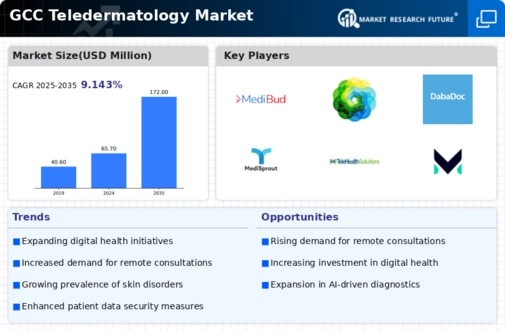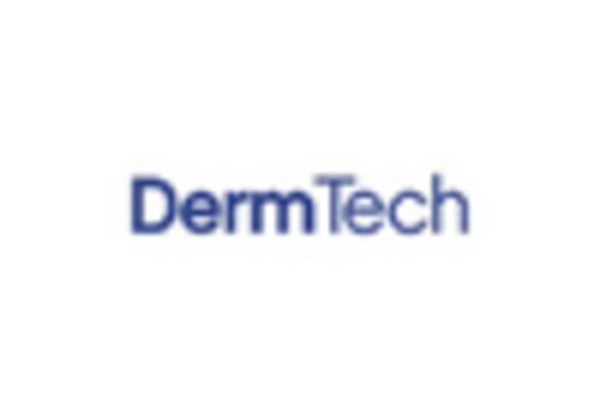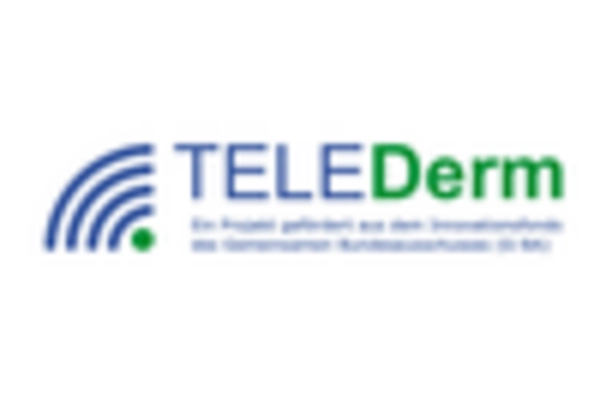Increased Internet Penetration
The rapid increase in internet penetration across the GCC region is a pivotal driver for the teledermatology market. As of 2025, internet penetration in the GCC is estimated to exceed 99%, facilitating easier access to telehealth services. This connectivity allows patients to consult dermatologists remotely, reducing the need for physical visits. The convenience of online consultations is appealing, particularly in rural areas where dermatological services may be limited. Furthermore, the proliferation of smartphones and mobile applications enhances the accessibility of teledermatology services. This trend indicates a growing acceptance of digital health solutions, which is likely to propel the teledermatology market forward, as more patients seek efficient and timely dermatological care.
Supportive Healthcare Policies
Supportive healthcare policies in the GCC are fostering the growth of the teledermatology market. Governments in the region are increasingly recognizing the importance of telehealth services and are implementing regulations that promote their use. For instance, initiatives aimed at integrating telemedicine into the healthcare system are being established, which enhances the legitimacy and acceptance of teledermatology. These policies not only facilitate reimbursement for telehealth services but also encourage healthcare providers to adopt digital solutions. As a result, the teledermatology market is likely to benefit from a more favorable regulatory environment, which could lead to increased investment and innovation in telehealth technologies.
Rising Awareness of Skin Health
The rising awareness of skin health among the population in the GCC is a crucial driver for the teledermatology market. Educational campaigns and increased access to information about skin conditions are leading to a more informed public. As individuals become more conscious of their skin health, they are more likely to seek professional advice and treatment. This trend is reflected in the growing number of online searches for dermatological information and services. Teledermatology provides a convenient platform for individuals to address their skin concerns without the barriers of traditional healthcare settings. Consequently, this heightened awareness is expected to drive demand for teledermatology services, contributing to the overall growth of the market.
Growing Dermatological Conditions
The increasing prevalence of dermatological conditions in the GCC region serves as a significant driver for the teledermatology market. Conditions such as acne, eczema, and skin cancer are becoming more common, prompting a higher demand for dermatological consultations. Reports suggest that skin diseases account for approximately 30% of all outpatient visits in the region. This rising incidence necessitates innovative solutions to manage patient care effectively. Teledermatology offers a viable alternative, allowing for quicker diagnosis and treatment plans. The ability to provide specialized care remotely is particularly beneficial in the GCC, where access to dermatologists may be limited in certain areas. As the population continues to grow, the demand for teledermatology services is expected to rise, further driving the market.
Cost-Effectiveness of Teledermatology
The cost-effectiveness of teledermatology is an essential driver influencing the teledermatology market in the GCC. Traditional dermatological consultations can be expensive, often involving travel and long waiting times. Teledermatology reduces these costs significantly, making it an attractive option for both patients and healthcare providers. Studies indicate that teledermatology can reduce consultation costs by up to 50%, which is particularly appealing in a region where healthcare expenses are rising. Additionally, the ability to provide timely care through remote consultations can lead to earlier interventions, potentially reducing the overall cost of treatment. This financial advantage is likely to encourage more patients to utilize teledermatology services, thereby expanding the market.

















Leave a Comment